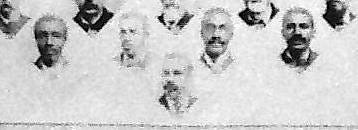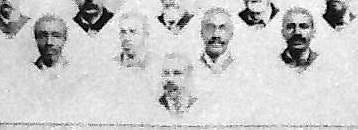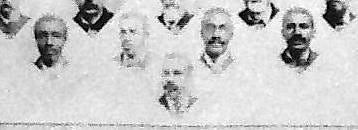More tales of North Carolina's 19th-century African American legislators
Part 2: Members of the General Assembly sessions of 1891, 1893, and 1895
Earlier this year, I began introducing readers to a handful of African American legislators elected to the North Carolina General Assembly during the nineteenth century, among more than 125 black state legislators, all Republicans, who held office between 1868 and 1900.
This week, I continue my occasional series on North Carolina’s black public servants during the period, many of whom I have written about in previous articles for the North Carolina Historical Review and in other publications. Today’s post explores the lives of legislators who were first elected to sessions of the General Assembly held between 1891 and 1895:
John S. Chapman (1848?-1934), of New Bern, served one term in the N.C. House of Representatives from Craven County as a Republican, elected in 1890. He was born in February 1848/1849 in North Carolina, probably in Craven County, the son of John and Matilda Chapman, perhaps freeborn. Little is known of his early life or education. He became a farmer and a minister.
He became active after the Civil War in the Craven County Republican Party. In 1890, Craven Republicans selected him as a nominee for a county seat in the N.C. House of Representatives. Elected later that year, served on the House Committee on Privileges and Elections in the 1891 session of the General Assembly. He did not seek reelection in 1892.
According to the Craven County censuses of 1870 and 1880, Chapman was then married to his first wife, Sophia, with one daughter, “Poos,” 8. After her death, he married Eugenia Smith, aged 25, on August 27, 1896. In the 1900 census, their household listed two other residents, Della Dove, 15, and nephew Henry Green, aged 6. The 1910 census listing includes a daughter, Cathie E. Chapman, aged 10. In the 1930 census, they are listed as living alone.
Chapman died on December 24, 1934, in Craven County, beneath the name “Rev. Johns S. Chapman.” His widow died in 1946. They are buried in Buck Cemetery in Vanceboro, alongside a child named Mary E. Chapman (1943-1948), possibly a grandchild.
* * * * * * *
William Bolland Henderson (1862-1937), of Henderson, served two terms in the N.C. Senate from the Eleventh District (Warren and Vance Counties), elected in 1892 and 1896. He was born in March 1862 in Granville County, listing his parents as Richard B. Henderson and Sallie Newton-Henderson. Little is known of his early life or education. He became a farmer.
In the 1880 census of Granville County, he was listed as living with his mother and two siblings. In the 1880s, he became active in the Republican Party of the newly-created Vance County. Vance Republicans selected him in 1892 as their nominee for the Eleventh District seat (Vance and Warren Counties) in the N. C. Senate. Elected later that year, he served in the 1893 session of the General Assembly.
He did not seek reelection in 1894, but was subsequently elected to the same Senate seat in 1896, and served his second term in the 1897 session of the General Assembly. He did not seek reelection in 1898.
He was married twice. His first wife was Alice Paschall-Henderson, whom he married in 1885; she died by 1910, according to the 1910 U.S. census. He then married Pocahontas Henderson, around 1922; she survived him. He had eight children, born between 1887 and 1903, including William Jr., Carrie B., Sallie L., Annie E., Katie E., Thomas, and Charlie.
In the 1930 census of Vance County, William and Pocahontas Henderson lived in Nutbush Township.
Henderson died on May 1, 1937, in Vance County. He is buried in that county’s Mount Pleasant Cemetery.
* * * * * * *
Samuel J. H. Mayes (1870-1921?), of Granville County, served one term in the N.C. House of Representatives as a Republican from Granville County, elected in 1894. Mayes was born on December 15, 1870, in Fishing Creek Township; his parents may have been Charles and Ann Mayes, who had eight children. Little is known about his early life, but he briefly attended Boydton Institute in Virginia, then left school in 1892 to return home and become a schoolteacher.
He was elected president of the Granville County Pine Grove Institute in 1894, according to his biographical sketch in the 1895 General Assembly Sketchbook. He became active in the Granville County Republican Party in the early 1890s, becoming chairman of the executive committee of Fishing Creek Township in 1894.
Samuel J. H. Mayes of Granville County (second from left) served in the 1895 MCGA session. Public domain photo
In 1894, Granville Republicans selected Mayes as their nominee for one of the county's seats in the N.C. House of Representatives. Elected later that year over five competing candidates, he served in the 1895 session of the General Assembly.
In his first political speech, he used the following words: “Fellow citizens, We have so many new parties now, when a new fellow gets up to speak the people want to know what party he belongs to. I am always proud to tell anyone the party I belong to; I belong to a party that rejoices when a fellow finds a gold mine, when the dews of heaven fall upon the fields of the poor; when their smokehouses are hanging thick with meat, and the pictures of Lincoln and Grant are hang upon the walls. And that party is the Republican party.”
After completing his legislative term, he returned to Granville County, where he was appointed as a magistrate for Fishing Creek Township in 1896.
In December 1899, he married Ella Geer of Durham, North Carolina. About 1900, Mayes moved his new bride to Philadelphia, Pennsylvania, where at least five daughters were born. One daughter, Josephine, was born and died in 1903; another unnamed daughter was born and died in 1909.
The 1920 U.S. census for Philadelphia lists Samuel Mayes, an insurance inspector, and wife, Ella, residing in that city with their three surviving daughters.
Mayes’ death date and place of interment are unknown. He is presumed to have died after 1920 in Philadelphia, where he is presumably buried.
* * * * * * *
Moses Matthias Peace (1861-1938) of Henderson, served two terms in the N.C. House of Representatives from Vance County as a Republican, elected in 1894 and 1896. He was born November 18, 1861, probably in Granville County, the son of Charles and Jane Peace, status unknown. Little is known of his early life; he had at least six siblings, and received his early education in the common schools of Henderson.
In the censuses of Granville County in 1870 and 1880, he was described as living with his family in Henderson, where his father was a carpenter. He attended Shaw University in Raleigh between 1880 and 1882, and then returned to Henderson to become a businessman and restaurant owner. He also became active in the Republican Party of newly-created Vance County, and was elected county coroner in 1892. He was also a delegate to the Republican state convention and the District Congressional convention in 1892.
In 1894, Vance Republicans selected him as their nominee for the county's seat in the N. C. House of Representatives. Elected later that year, he served on the House Committees on Institutions for the Deaf and Dumb, and Justices of the Peace during the 1895 session of the General Assembly.
Moses M. Peace of Henderson (second from right) served in the 1895 session of NCGA. Public domain photo.
In 1896, Peace was reelected to the seat, serving in the 1897 session of the General Assembly. He did not seek reelection in 1898.
Peace was quite active in his local church, becoming clerk, a deacon, and teacher of the First Baptist Sunday school of Henderson; he was church superintendent for eight years. An active Freemason, he helped formed a lodge at Henderson.
In 1887, he married his wife, Kittie Eaton; their children included sons William, Earnest, and Moses, and daughter Claudia, all born by 1895. By 1900, the Peace family then moved on to Washington, D.C., where he worked as a U.S. government laborer.
Peace was still living and working as a government laborer in Washington in 1920, according to that year’s census, and lodging with the family of Lindsay Jones; his wife died there on March 19, 1927, and is buried at National Harmony Cemetery in nearby Hyattsville, Maryland. He continued to live in Washington; in the 1930 census, he was recorded as still lodging with Jones, but no longer working.
Peace died in Washington in June 1938. He is buried in Lincoln Memorial Cemetery in nearby Suitland, Maryland.
* * * * * * *
Calvin L. Smith (1857-1901?), of Milton, served one term in the N.C. House of Representatives from Caswell County as a Republican, elected in 1894. He was born in Caswell County in 1857, probably to an enslaved mother. His parents’s names are not known; he is listed in the censuses of 1870 and 1880 as living with the family of an uncle, Atkinson McAden. Little else is known about his early life, but he was likely first educated in the county's common schools after the Civil War.
Calvin L. Smith of Milton (far right) served in NCGA during the 1895 session. Public domain photo
Between 1872 and 1877, Smith was a student at Lincoln University in Pennsylvania, where he was classmates with a New Jersey student named William P. Q. Webster, also a future state legislator in North Carolina. By 1880, Smith had returned to Caswell County to become a schoolteacher, as indicated in the 1880 census; by 1900, he was also serving as a storekeeper and gauger for the U.S. Internal Revenue Service.
He also became active in the Caswell County Republican Party, which selected him in 1894 as its candidate for the county's seat in the N.C. House of Representatives. After his election later that year, he served during the 1895 session of the General Assembly on the House Committee on the Election of Trustees of University, and on the Joint House-Senate Committee to fill vacancies on the board of trustees for the new A&M College in Greensboro.
He was apparently married between 1880 and 1900, but his wife’s name is not known, nor are the names of any children. In the 1900 census of Caswell County, Smith was listed as a widower; it is the last time he appears there. He continued to be listed in the Federal Register of civilian employees as a storekeeper and gauger until 1905.
Smith’s death date and place of interment are unknown. He is presumed to have died in Caswell County sometime after 1906.
* * * * * * *
Taswell L. Taylor (1860-1911?), of Oxford, served one term in the N. C. House of Representatives from Granville County as a Republican, elected in 1892. He was born on July 3, 1860, probably to an enslaved mother in Granville County. Little else is known of his early life; his education was described as “limited” in his biographical sketch in the 1893 General Assembly Sketchbook. He became a carpenter.
In the 1870 census of Granville County, he and three younger siblings were listed as living with the family of Smith and Violet Taylor, who were presumably their parents or guardians.
Before entering the legislature, he had been a member of the African Methodist Episcopal Zion church for 15 years, and superintendent of the Sunday school for 10 years, as well as a trustee and treasurer of the Quarterly Conference. He was a trustee of the Carr Academy at Norwood, in Stanly County. He was appointed as a justice of the peace for Granville County by the General Assembly in the mid-1890s.
In the late 1890s, he became active in the Granville County Republican Party, which selected him as its nominee in 1892 for one of the county's seats in the N.C. House of Representatives. Elected later that year, he served on the House Committees on Education and Deaf and Dumb Asylum during the 1893 session of the General Assembly. He did not seek reelection in 1894.
On May 21, 1884, Taylor married his first wife, Kittie Redley of Oxford; they had three children, whose names are not listed in the Sketchbook biography. Kittie Taylor apparently died before the 1900 census of Granville County, when Taylor was listed only as a carpenter boarding at a home in Oxford, without family.
In October 1900, Taylor married his second wife, Ada Taylor, of New York City. By 1910, Taylor had moved to New York City, according to that year’s census. He was working as a janitor in an apartment building. His son, Taswell, Jr., 19, lived with them in Manhattan.
Taylor’s death date and place of interment are unknown. He is presumed to have died in New York sometime after 1911.
* * * * * *
John Henry Wright (1858?-1925), of Warrenton, served a part of two terms in the N.C. House of Representatives from Warren County as a Republican, elected in 1892 and 1898. Wright was born in 1858/1859, probably in Warren County to an enslaved mother, Nancy Boyd, and Richard Wright. Little else is known of his early life, but he likely first attended the common schools of Warren County. He became a farmer and schoolteacher.
The 1870 and 1880 censuses of Warren County both show him working as a farm laborer and living with his parents and six siblings. How much teacher training he received, how long he taught school, and in which schools he taught, are not clear from the record. He almost certainly taught for a time in Warren County, and doubtless continued into later life after leaving politics; his occupation was listed as “schoolteacher” on his death certificate.
In the 1880s, he became active in the Warren County Republican Party, which selected him as its nominee several times—beginning in 1890—for a county seat in the N.C. House of Representatives. After losing the race in 1890, he was elected in November 1892, and initially seated by the House during the 1893 session of the General Assembly. Wright was then unseated in late January 1893 after a successful contest mounted by his predecessor and Democratic opponent, W. W. Long of Arcola, spawning a debate covered in detail on the front pages of daily newspapers in Raleigh.
John H. Wright of Warren County (far right) served in NCGA sessions of 1893 and 1899. Public domain photo
Wright may also have been the unsuccessful Republican candidate for the same seat in 1894, which was won by W. B. Fleming. Wright was subsequently reelected to his old seat in 1898, receiving 2,479 votes to a total of 615 for four other candidates, and thereafter serving his only full term in the 1899 session of the General Assembly. He did not seek reelection in 1900.
During the late 1890s, he also served as a county commissioner in Warren County (perhaps replacing W. E. Hall, a commissioner who reportedly fled the county). He resigned from the commission in November 1898, after his final election to the General Assembly.
In the 1900 census of Warren County, Wright is listed as a farm laborer, again residing with his parents and siblings in Sixpound Township.
Wright appears to have been married first to Millie G. Carter (ca. 1885), who died before 1900. After her death, he married Nellie C. Carter in 1902, and had two daughters with her by 1920: Anna J. Wright (born 1903), and Bessie B. Wright (1905), according to the censuses of 1910 and 1920. His son, John Hawkins Wright, was born in 1921.
Wright died in Sixpound Township on January 18, 1925. His place of interment is not known, but he may be buried in Pine Grove Church Cemetery in Macon, with his wife Nellie, who died in Littleton in 1950, and son, who died in 2000.
Next time: Members of the 1897 and 1899 sessions of the General Assembly






